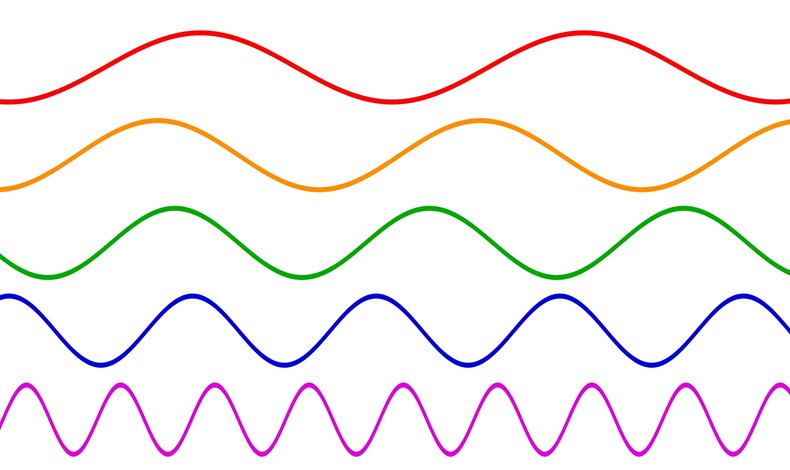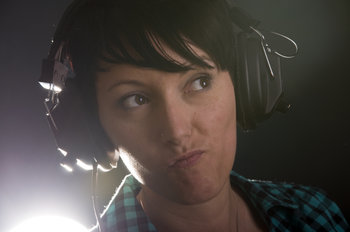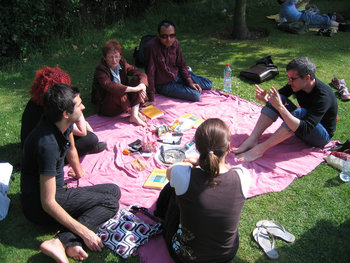|
| |
Sound is the human perception of acoustic waves that propagate through a medium. Acoustic waves that can't be perceived by humans are known as ultrasound and infrasound. Sound is important to human survival, communication and culture as it is a means of quickly transmitting or detecting events, information, emotion and expression. The following are the basic characteristics of sound.
FrequencyAudio frequency is the number of times a sound wave repeats in a unit of time.| Type | Frequency | | Sound | 20 Hz and 20 kHz | | Infrasound | < 20 Hz | | Ultrasound | > 20 kHz |
PitchHuman hearing maps frequency to pitch. This can be described on a range from high to low. The mind makes only a rough mapping from the actual sound wave to pitch. Accurate perception of pitch is a valued musical ability that is much easier to acquire from a young age.
DurationThe duration of a sound is a critical element of music and communication.NoteA music note is the combination of pitch and duration.PhraseIn music, a phrase is a collection of notes that is complete enough to be considered music on its own. For example, the melody of a song.TimbreTimbre are elements of sound that are independent of note. For example, the voice of a person. Likewise, the same note sounds very different on different instruments. This is the timbre of the instrument or voice.TempoThe speed at which notes are played. Often measured in beats per minute.RhythmA repeated pattern of strong and weak elements in music. This has a similar meaning in linguistics where it describes the rate of speech together with pauses and stressed points that create a pattern.MelodyA sequence of notes that the listener perceives as musically satisfying.HarmonyHarmony is the total perception of multiple simultaneous sound waves. For example, a musical piece may bombard the listener with dozens of instruments playing simultaneously and the brain works to appreciate these sounds as a single song. As this is a relatively complex cognitive task, it is subjective.TextureTexture is the overall effect of multiple concurrent sounds. It could be described as the combination of tempo, melody and harmony.ArticulationIn linguistics, articulation is the clarity and accuracy of each individual sound. This term is also used in music where it is applied to the accuracy of each note.LoudnessLoudness is the amount of pressure exerted by a sound wave. This can be measured with sensors in decibels.DynamicsIn music, dynamics is the variation in loudness between notes or phrases. Advanced dynamics may also include expressive variations in the timbre and tempo that occurs between notes.EnvelopeA music term for how a sound changes with time. Often described according to the following stages.| Stage | Description | | Attack | The initial run up to the peak of the sound. | | Decay | The run down from peak to some sustained level. | | Sustain | The longest stable sound in the envelope. | | Release | The decay of the sound back to zero. |
ReverbReverb is how a sound decays in an environment as sound waves bounce off things. A familiar example is an echo. Different reverb effects are intentionally added to electronic music such that they become part of the envelope.ResonanceResonance is the ability for sound waves to trigger vibrations that cause secondary sounds. For example, a drum beat that causes the strings on a guitar to vibrate. Resonance is also commonly used to describe full and rich sounds. This is essentially an analogy to a sound so rich that it shakes the room.SilenceSilence adds to sound and often makes it more expressive, intelligible and pleasing. Silence is the negative space of music and communication.ToneAs a musical term, tone refers to the duration, pitch, loudness and timbre of a note. It is also used more broadly to indicate the total presence of a sound including elements such as talent, instrument, technology and environment. As a linguistics term, tone has much the same meaning and indicates the total effects of a sound -- also known as intonation.Spatial DirectionHumans can estimate the location and distance of a sound source. This quality of sound is known as spatial direction. SpeedThe speed of sound is about 761.2 mph or 1,225 kmh at sea level at a temperature of 59 °F (15 °C). The following conditions greatly influence the speed of sound: | Condition | Effect | | Altitude ↑ | Speed of Sound ↓ | | Temperature ↑ | Speed of Sound ↓ | | Density ↑ | Speed of Sound ↑ |
Generally speaking, sound travels faster through liquids and solids than air. For example, sound travels around 4.3x faster through water, 15x faster through iron and 35x faster through a diamond as compared to air.
Sound
This is the complete list of articles we have written about sound.
If you enjoyed this page, please consider bookmarking Simplicable.
TrendingThe most popular articles on Simplicable in the past day.
Recent posts or updates on Simplicable.
Site Map
© 2010-2023 Simplicable. All Rights Reserved. Reproduction of materials found on this site, in any form, without explicit permission is prohibited.
View credits & copyrights or citation information for this page.
|























